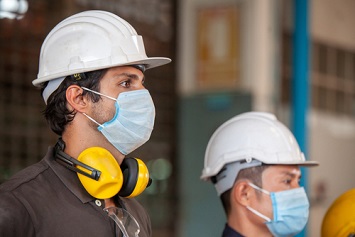Building an ideal safety culture requires a focus on a variety of factors, including Leadership, Systems, Behaviors, Employee Engagement, Internal Person Factors, and Conditions. Therefore, protecting ourselves and others in an optimal way has always required a variety of interventions. This has never been more true than during these times of COVID-19.
Intervention Effectiveness
Most hierarchies of intervention effectiveness include “Eliminating the Hazard” at the top, or as most effective. Interventions such as PPE are typically at the bottom, or ranked as least effective. This ranking also holds true for the ongoing COVID-19 pandemic.
Of course, the most effective way to control the hazard is to eliminate the threat. This is the goal of developing vaccines and therapies for COVID-19. However, this is now in the hands of the scientists and researchers. Until these medications and therapies are available, we must rely on lower level interventions to control or mitigate the threat.
Whether it is mask use or physical distancing to mitigate the hazards of COVID-19 exposure or some other behavior to protect ourselves and others from a variety of other hazards, one thing is clear. If we ask employees to perform certain behaviors, and those behaviors are uncomfortable, inconvenient, or time consuming, we may get pushback or reluctance to comply.
Therefore, whenever we ask employees to take personal responsibility to perform difficult or inconvenient behaviors, it will be useful to ask if they can answer affirmatively to three questions derived from social learning theory.
The Three Key Questions
First question: “Can you do it? Do you have the resources, the time, the knowledge, and the skills to perform the behavior or task?” But knowing you have the relevant skills and resources to perform a particular task is not enough to feel empowered and self-motivated. Thus, the second question: “Will it work? Do you believe that performing the behavior will lead to the desired outcome?” The third question is a motivational question: “Is it worth it?” Are the consequences sufficient to motivate the effort or inconvenience needed to perform the behavior?
The example I have used for years related to these questions has been to consider an emergency stop button on an assembly line. If we ask the line-workers whether they believe they are physically able to hit the E-stop, we would almost certainly get a “yes” answer. Likewise, it is reasonable to expect employees believe hitting the E-stop would actually stop the line and control/eliminate a hazard. However, in this example, a “yes” to the motivational question is not obvious and depends somewhat on the anticipated consequences. What happened to the last several people who hit the E-stop? Were they thanked? Were they chastised for slowing down production? Were they put on a less desirable line or job? The answers to these questions from past experiences will greatly influence employee perceptions when determining the cost/benefit analysis related to this behavior.
Now, let’s use the same logic to consider motivating mask use to mitigate the hazards of COVID-19 exposure. Instead of simply dictating to employees “You must use a mask,” consider instead whether employees can answer affirmatively to the following three questions:
1. Can I do it?
Are masks available? Do they fit properly? Do they lead to other issues such as glasses fogging up and potentially creating other hazards? Have we adequately dealt with these issues?
2. Will it work?
During the first stages of the COVID-19 crisis, there were conflicting recommendations from the WHO, CDC, and other various agencies regarding mask effectiveness and recommendations for use. Are we staying up to date and using the most current information from respected sources to guide our thinking about the effectiveness of masks?
3. Is it worth it?
Don’t only consider the probable consequences, but also the possible consequences. Consider how contracting COVID-19 could affect us personally, our family, and loved ones. Consider the fact that we may have it, but we may be asymptomatic and could possibly be spreading it to others more vulnerable than ourselves without our knowledge. Consider the examples we set and whether it’s worth it to do our part in creating an Actively Caring culture, where we are all looking out for each other.
Conclusion
Building an ideal safety culture takes all of us doing the right thing to keep both ourselves and those around us safe and protected. As leaders, consider how much more effective we would be at ensuring mask use, as well as other critical safety related behaviors, if we move beyond mere mandates and instead, we motivated all to do the right thing by supporting the entire organization in answering affirmatively to the above 3 questions.
 Steve Roberts is co-founder and senior partner at Safety Performance Solutions. He earned an M.A. and Ph.D. from Virginia Tech with a focus in Organizational Behavior Management. For the past 30 years, his areas of expertise include the implementation and evaluation of behavior and people-based safety processes, the assessment of organizational culture, management systems design, organizational leadership development, and reducing human error in the workplace. Steve taught the ASSE Seminarfest course People-Based Safety each year from 2005 to 2018, and he authored the book chapter “Actively Caring for Occupational Safety: Preventing Injuries with People Based Safety,” in Dr. E. Scott Geller’s 2013 book Actively Caring for People: Cultivating a Culture of Compassion. Steve is also lead author for the book chapter “Principles of Behavior-Based Safety” in the Handbook of Safety Principles, edited by Niklas Möller of Sweden’s Royal Institute of Technology, published in 2018 by John Wiley & Sons. Steve Roberts is co-founder and senior partner at Safety Performance Solutions. He earned an M.A. and Ph.D. from Virginia Tech with a focus in Organizational Behavior Management. For the past 30 years, his areas of expertise include the implementation and evaluation of behavior and people-based safety processes, the assessment of organizational culture, management systems design, organizational leadership development, and reducing human error in the workplace. Steve taught the ASSE Seminarfest course People-Based Safety each year from 2005 to 2018, and he authored the book chapter “Actively Caring for Occupational Safety: Preventing Injuries with People Based Safety,” in Dr. E. Scott Geller’s 2013 book Actively Caring for People: Cultivating a Culture of Compassion. Steve is also lead author for the book chapter “Principles of Behavior-Based Safety” in the Handbook of Safety Principles, edited by Niklas Möller of Sweden’s Royal Institute of Technology, published in 2018 by John Wiley & Sons.
To learn more from Steve about building an ideal safety culture, check out his on-demand webinar, Safety Culture Essentials: Effective Strategies for Gaining Buy-in and Boosting Safety Success, available from the BLR store. |

